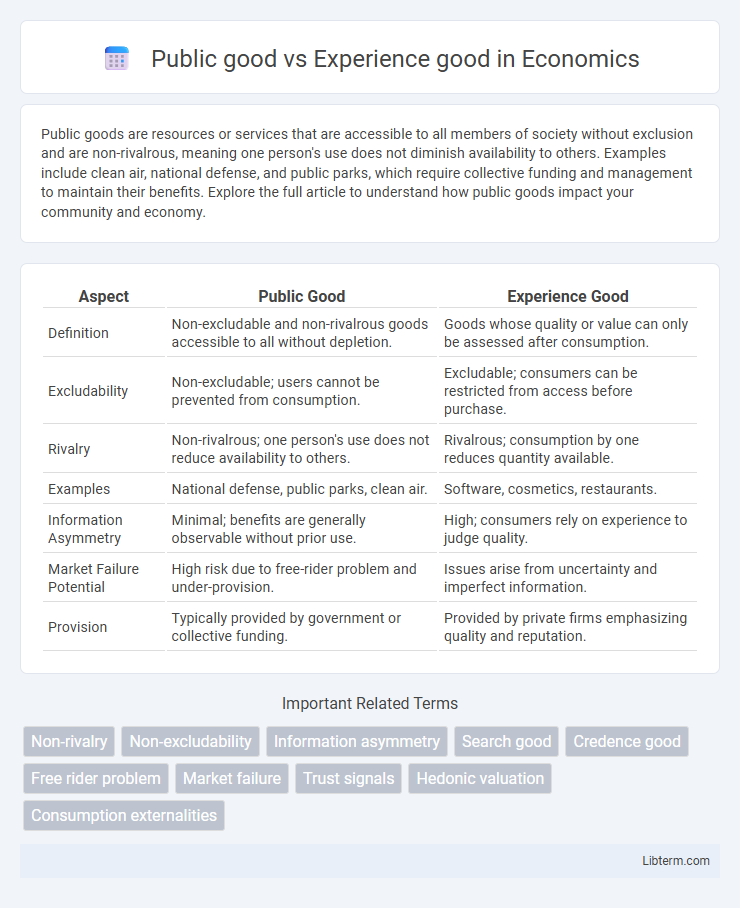Public goods are resources or services that are accessible to all members of society without exclusion and are non-rivalrous, meaning one person's use does not diminish availability to others. Examples include clean air, national defense, and public parks, which require collective funding and management to maintain their benefits. Explore the full article to understand how public goods impact your community and economy.
Table of Comparison
| Aspect | Public Good | Experience Good |
|---|---|---|
| Definition | Non-excludable and non-rivalrous goods accessible to all without depletion. | Goods whose quality or value can only be assessed after consumption. |
| Excludability | Non-excludable; users cannot be prevented from consumption. | Excludable; consumers can be restricted from access before purchase. |
| Rivalry | Non-rivalrous; one person's use does not reduce availability to others. | Rivalrous; consumption by one reduces quantity available. |
| Examples | National defense, public parks, clean air. | Software, cosmetics, restaurants. |
| Information Asymmetry | Minimal; benefits are generally observable without prior use. | High; consumers rely on experience to judge quality. |
| Market Failure Potential | High risk due to free-rider problem and under-provision. | Issues arise from uncertainty and imperfect information. |
| Provision | Typically provided by government or collective funding. | Provided by private firms emphasizing quality and reputation. |
Understanding Public Goods: Definition and Characteristics
Public goods exhibit unique characteristics such as non-excludability and non-rivalry, meaning they can be consumed by many without reducing availability to others and cannot exclude individuals from usage. Examples include national defense and public parks, which provide widespread benefits regardless of individual contribution. Understanding public goods is critical for effective policy-making as markets often fail to allocate these goods efficiently due to free-rider problems.
What Are Experience Goods? Key Features Explained
Experience goods are products or services whose qualities and value can only be accurately assessed after consumption or use, making pre-purchase information incomplete or unreliable. Key features include the necessity for consumer experience to evaluate attributes such as taste, comfort, or effectiveness, leading to uncertainty and reliance on reviews, trials, or brand reputation. Unlike public goods, which are non-excludable and non-rivalrous, experience goods are private goods with consumption benefits that vary based on subjective user experience.
Public Goods vs Experience Goods: Core Differences
Public goods are characterized by non-excludability and non-rivalry, meaning they can be consumed by multiple individuals without depletion or exclusion, such as clean air or national defense. Experience goods, in contrast, require consumption before their value or quality can be accurately assessed, examples include restaurants or software services. The core difference lies in consumption and evaluation: public goods provide universal access without direct experience, while experience goods require personal usage to determine satisfaction or utility.
Examples of Public Goods in the Real World
Clean air, national defense, and public parks are classic examples of public goods characterized by non-excludability and non-rivalrous consumption. These goods provide benefits to all individuals without reducing availability, making private market provision inefficient. Public broadcasting and street lighting also exemplify public goods that enhance societal welfare without direct personal payment.
Real-Life Cases of Experience Goods
Experience goods, such as restaurant meals and streaming services, require consumption before their quality can be accurately assessed by consumers. Real-life cases include Netflix, where users evaluate content quality only after watching, and restaurants relying on customer reviews to signal dining experience. Unlike public goods that are non-excludable and non-rivalrous, experience goods depend heavily on reputation and post-purchase evaluation for market success.
Consumption Patterns: Public versus Experience Goods
Public goods are non-excludable and non-rivalrous, allowing simultaneous consumption by multiple individuals without diminishing availability; this leads to widespread collective usage patterns. Experience goods require personal consumption before value assessment, resulting in varied and subjective consumption habits influenced by individual preferences and prior experiences. These differing consumption patterns highlight the contrast between the shared accessibility of public goods and the personalized evaluation necessary for experience goods.
The Challenge of Valuing Experience Goods
Experience goods pose a unique valuation challenge due to their quality being ascertainable only after consumption, unlike public goods which are non-rivalrous and non-excludable. Consumers must rely on signals like reviews, brand reputation, or trial periods to assess experience goods, complicating market efficiency and pricing strategies. This uncertainty often results in asymmetric information, leading to potential market failures such as adverse selection or moral hazard.
Market Failures in Public and Experience Goods
Public goods, characterized by non-excludability and non-rivalry, often lead to market failures due to free-rider problems where individuals consume benefits without paying, resulting in underproduction. Experience goods suffer from asymmetric information because consumers cannot assess quality before purchase, causing adverse selection and inefficient market outcomes. Both types of goods require government intervention or innovative mechanisms to correct these market failures and improve social welfare.
Policy Approaches for Public and Experience Goods
Policy approaches for public goods emphasize non-excludability and non-rivalry, often involving government provision or financing to overcome free-rider problems and ensure universal access. For experience goods, policies focus on reducing information asymmetry through quality standards, consumer protection regulations, and transparent reviews to help consumers evaluate product value before or after purchase. Effective regulation balances market efficiency with equity, tailoring interventions to the distinct consumption and information characteristics of public versus experience goods.
Future Trends: Public and Experience Goods in the Digital Age
Public goods in the digital age are increasingly shaped by blockchain technology and decentralized platforms, ensuring transparency and equitable access, while experience goods leverage artificial intelligence and big data to personalize user experiences and predict customer preferences with higher accuracy. The rise of virtual and augmented reality technologies transforms experience goods by enhancing sensory engagement and user interaction, creating immersive digital environments that redefine value perception. Future trends indicate a convergence where digital public goods, such as open-source software and shared knowledge bases, integrate with experience goods through platforms offering customizable, real-time feedback and adaptive content delivery.
Public good Infographic

 libterm.com
libterm.com